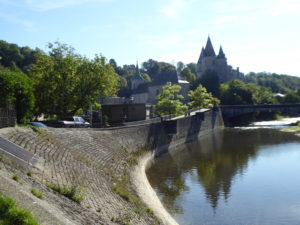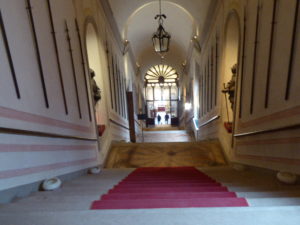So now it’s the Porsche’s turn! This is easy all tarmac tour to Northern Italy, outbound via the Jaufen Pass and returning via the Stelvio. In between we hope to visit various tourist routes – Black Forest High Road, Prosecco Route, Clock Road, Great Dolomite Road and the Porsche factory. This is the route outline:
Map
We had planned to visit Dinant en-route to the Ardennes and our tea stop in Durbuy but decided to give it a miss – and were later told it was heaving! Durbuy is picture postcard with an old castle and a steep sided, tree clad hill separated from the town by a gentle river – the Ourthe. 

The Ardennes, so peaceful now was not always so and we stopped at one of the roadside memorials to the fallen.
Then to the overnight stop in Petange, Luxembourg, where we met the remaining members of the tour group, having met some on the ferry – have to say we were most disappointed with the P&O ferry; looking forward to a cooked breakfast there was just an array of cabinets with pre-packed rolls and paper cups.
The ‘welcome meal’ in Luxembourg by contrast served enormous portions and absolute confusion over which description tallied with which dish so that plates were passed around the table until we all got maybe what we ordered.
The second day should also have been 5 1/2 hours drive but this time we were the last to arrive at the overnight stop at – Schloss Hornberg in the Black Forest. Our first stop was Baden Baden
where we had hoped to buy some Baden wine – and we did as we found the Kurhaus was holding a “taste and buy” event. Then we followed the Black Forest High Road, route 500, to Freudenstadt, a city created in 1599 by Friedrich of Wurtembourg, with a huge central square, each side 220 metres long. Our late tea of cake and wine perhaps clouded my judgement as, when I entered Hornberg into the sat nav, I didn’t realise that the Hornberg it showed was 45kms northeast, whilst I needed to be at the Hornberg 45kms south west….. Result a sharp drive in the gathering gloom along narrow winding roads or frustratingly lorry-occupied main roads to find that the rest of the group were, embarrassingly, waiting for us to arrive to start their meal.
Day 3 was a rest day and the best laid plans were shown to be wanting. I had planned a train journey on the short stretch between Hornberg and St Georgen which was a engineering challenge to drive a line through such hilly terrain – 11 kms as the crow flies translated into 26 kms of track, a height change of 443 metres, 39 tunnels and a maximum gradient of 2%. Sadly the timetable had changed and there were no realistic there and back timetable combinations. So we started on the Deutsche Uhr Strasse – the Clock Road. Our first stop was Schramberg which boasts four museums – we managed two of them. The Car museum has over 130 cars, mostly German with 3 Rolls Royce and two MG’s. There were a number of American cars, mainly with Ohio registrations – the museum owner had owned factories in Ohio and collected a number of cars, mostly restored but as an interesting angle, one was displayed “as found in a barn”
A 911 was shown as a crushed cube of rusted metal with wheel rims and exhaust the most recognisable parts. A Ferrari, front end impacted was displayed with no engine, smashed windscreen and severely shortened front end. Amazingly the passenger compartment was largely intact.
Allison had been most put out that after two days in Germany, schnitzel had not found its way to our menus – so we found her one at a Vietnamese run Gasthaus across the road from the museum.
The second museum – cars and clocks was housed in an old clock factory, whose size and original range of buildings was extraordinary. This one was 5 storeys and 3,500 sq metres. This had the smaller cars, names largely forgotten, Lloyd, Borgward, Goggomobile, bubble cars and many more (I have forgotten their names!).
Leaving this we tried to follow the Clock Road – but it was next to impossible, the signposting was awful – pointing the way and then nothing at the next junction, whilst carrying on, did just that, on and on. The few clocks we saw were on public buildings so all in all, a waste of time.
Our route on day 4 was south east to Lake Konstanz – but we headed slightly north of east to Burg Hohernzollern, the seat of the rulers of Brandenburg, Prussia and Germany for many centuries. The castle loomed out of the cloud as we approached, its turrets giving it a fairy tale scene. Fortunately we were amongst the early arrivals and our tour of the interior was pretty much to ourselves. In the car park we had been asked if we were members of Porsche Club as 20 or so club cars were expected and had reserved parking. Our reply that we were members but not of that club caused some confusion; having seen them arrive as we were leaving the museum the day before at Schramberg we wonder what our next meeting with then will be. 



Then onwards to Friedrichshafen, home of the Zeppelin airships.
This had become a ‘must see’ on the trip following a talk we attended, during the recent ‘Heritage Open Days’ fortnight, about the Pulham Pigs. The Pigs were the British airships, based at Pulham St Mary in Norfolk from around 1912 until the airship programme was halted following the disaster of R101 in 1930. The Friedrichshafen museum shows the history of the German airship programme until its similar tragedy with the LZ129 Hindenburg in 1937. Then to our overnight stop in Bregenz – where it rained, luckily after our promenade along the lake front. Tomorrow its the Alps – and it might get cold!
Next door to Bregenz (relatively) is Liechtenstein, which we have missed in the past so our first priority was to get to Vaduz for morning coffee. We chose the scenic route so as to avoid Swiss motorways and the vignette. From there we rejoined the route via St Anton towards Bolsano
From St Anton we took the Oetztal route to an empty Obergurgl and past the motorcycle museum to Merano and on to Bolzano
Tuesday started wet and cold with hail which didn’t bode well. Fortunately the sun appeared after a coffee stop in Canazei on the Great Dolomite Road, built in the early years of the 20th century.
This area had been the front line in WW1 between the Austro-Hungarian Empire and Italy so we planned to visit some of the sites. The Livinallongo museum was closed as was the much older Andraz Casle and the museum at Forte Tre Sassi – but we could see the outside!
A climb from the fort lead to the reconstructed trenches – constructed from rocks with very limited shelter from either enemy fire or the elements.
Our hotel for the next four nights might be described as being the middle of nowhere – except Prosecco country.
One suggested activity was the Prosecco Route but given our success with following such “routes” that seems unlikely and others in the group, who tried, said it didn’t work and the few wineries they found were closed! Another suggestion was Lake Garda – that we did and it’s a very nice lake, with steep hills dropping into the water and tourist cafes (some already closed for the season) if you can find parking – but its 2 1/2 hours driving each way to get there!
We drove down the east bank and found a road to the village of Castelletto, nestling in the hills whose main claim to fame seemed to be the old mule tracks which lead higher than we wanted to explore.
The next day started wet but the hotel had kindly offered a guided tour. Perched on a hilltop with commanding views over the locality, the existing building has a 16th century centre with additions in the 18th; owned by the Brandolini family for 4 centuries, it changed hands in 1959 after the owner racked up excessive gambling debts and was bought by the existing owner in 1997, opening as a hotel in 2002 after 5 years of restoration.
The clouds cleared in the afternoon for us to visit the local towns of Cison
and slightly further afield, Conegliano, with an interesting museum in its old castle, and Collalto with a castle, bombed in WW1 now being restored.
On our return to the hotel, the skies darkened, we were enveloped in cloud whilst thunder, lightening and rain washed over us – hopefully tomorrow will be consistently fine!
Well it wasn’t fully fine but it was better the next day when our first stop was Bassano del Grappa. The town’s main claim to fame, aside from the Grappa liqeur is the Palladian covered bridge
The Sturm Palace museum on the riverbank houses collections of printing and ceramics. Allison’s interest was the story of the Remondini print company – one of the first major printing companies but whose fortunes declined when they continued with religious texts rather than romantic novels in the mid 1800’s. . Our next stop was “chess town”. So called because every two years Marostica hosts chess games with actors playing the pieces. Today the square and chess board were deserted and damp. We climbed the path behind the church to the castle – private property, no entry – and found that it was a B&B; that would make an interesting stop-over on a future Scenic tour. We found our 4 night stay in the impressive CastelBrando a bit too much so will suggest this to the organiser for their future tours. On the walk up we saw a couple of beehives and this sign – I’ve not seen a beware bees sign before!After another large, late supper the next day was perhaps the driving highlight of the trip – The Stelvio Pass. The second highest pass in the eastern Alps it was built for the military in the 1820’s with 48 or so hairpins up and down. To get there we had first to get up the Gavia Pass to Bormio – actually a much narrower and more challenging than the relatively main road Stelvio. Doc4(not sure if this picture of the Gavia Pass will show up!) Then an easy run to our hotel just inside Italy in Tyrol – a German speaking area which used to be Austria and many believe still should be.
And on to Germany, passing briefly through Austria near St Anton in Arlberg, which we had visited on the outward journey with an overnight in Fussen, Bavaria.
. It was raining when we reached the ruins of Ehrenberg but we reached the top – deciding against the “highline” bridge linking it to its neighbour on the next hilltop. . Ehrenberg had been an important part of the local defences and guardian of the toll road below but technology moved on and when attackers dragged siege engines up to a neighbouring hilltop, its position of strength made it a sitting duck as it was bombarded into submission and decline.Fussen is a attractive town with its AltStadt (in the dry)
At this stage we decided to break off early and return home. The next day was a bank holiday for German Unification Day and many museums were closed. Two fairy tale castle we would have liked to visit at Schwangau had entry by ticket only and no more tickets were available till after we would have left. We overnighted at Bitburg (of Bitte Ein Bit fame) and a fast trouble free run via Calais.










































